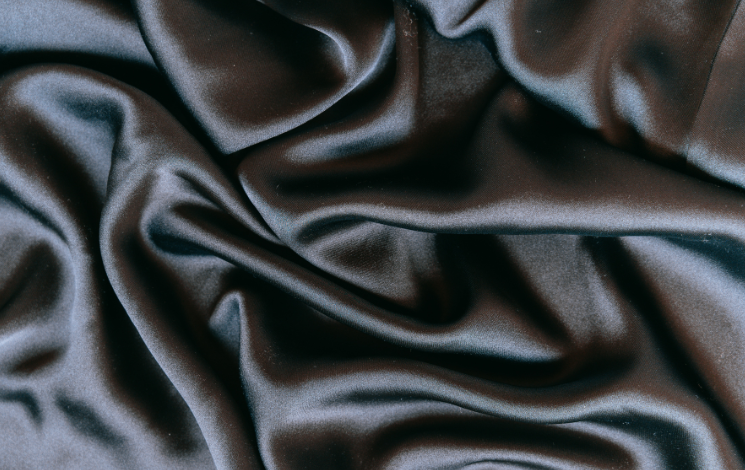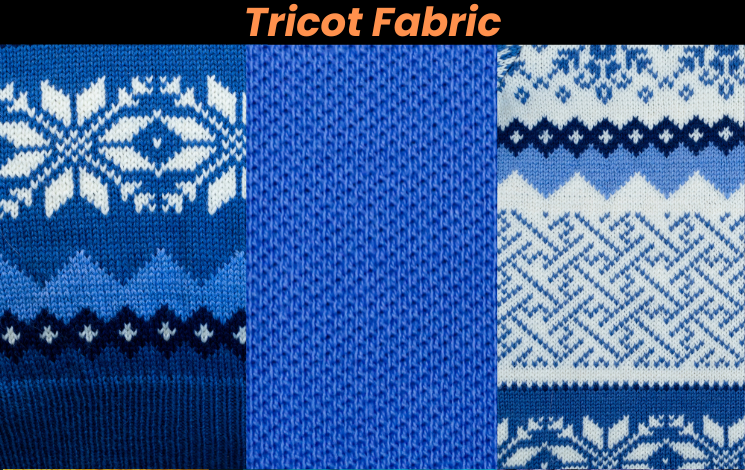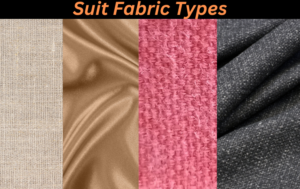Tricot Fabric Structure, Characteristics Uses and Benefits with Images
Tricot fabric is a popular choice of material used to create apparel and home décor items. With its distinctively soft, lightweight feel, durable, comfortable, and versatile material.
Its twill-like weave gives it a unique texture that is pleasant to the touch. its smooth, glossy surface, which is created by a combination of interlacing warp and weft yarns.
It has a unique stretchability that allows it to be used to create garments that are form-fitting and comfortable. Thanks to its breathability and moisture-wicking properties, it is a great choice for warm-weather clothing.
tricot fabric used for
ideal choice for a variety of purposes. Its range of textures and colors make it suitable for clothing, upholstery, and even blankets.
Its soft, lightweight construction lends itself to many types of garments, from lingerie to athletic wear. Its durability and easy care make it the perfect choice for all your fabric needs.
Types of Tricot
Moving on from its history, let’s take a look at the types available today. There are two main varieties of warp knit and weft knit.
Warp knits

Warp knits are formed by looping yarns over and under each other, stretching from one side of the fabric to the other. This type of knitting is tighter and more durable than other knit fabrics.
Weft knits

Weft knits, on the other hand, are created by looping yarns back and forth in columns. This type of knitting is less durable, but produces a fabric that is softer and stretchier than warp knits.
Tricot fabric is also available in a range of finishes, from smooth and shiny to more matte and textured. This allows for a variety of effects when working making it a great choice for a wide range of projects.
From lightweight baby blankets to stylish evening dresses, fabric can be used to create a variety of stylish and functional garments. With its range of textures, finishes, and colors, tricot is a great choice for any sewing project.
Uses of Tricot
Care of Tricot
is tricot fabric warm?
it is often used to create warm clothing items due to its thick, soft texture. It is a type of knit fabric that is crafted with interlocking loops of yarn and is available in a variety of weights and textures.
Its versatility makes it suitable for a range of garments, from casual to formal wear, and its warmth and breathability offer a high level of comfort to wearers.
Types of Tricot Fabric
Cotton tricot fabric

Cotton tricot is no longer the only type of tricot available. Today, there are many varieties each with its own unique properties. Varieties include wool, rayon, silk, and polyester.
Wool tricot fabric

Wool tricot fabric is the most lightweight of all the varieties. With a soft and warm feel, this fabric is perfect for use in winter clothing. It is also highly durable and resists wrinkling.
Rayon tricot fabric

Rayon fabric is lightweight and has a smooth, silky feel. It drapes well and is often used in eveningwear. This fabric also holds its shape better than other types
Silk tricot fabric

Silk tricot fabric is the most luxurious of all tricot fabrics. Lightweight and soft, this fabric is perfect for special occasions or elegant events. It is also highly resistant to damage and is extremely durable.
Polyester tricot fabric

Polyester tricot fabric is the most versatile of all tricot fabrics. It is lightweight, durable, and wrinkle-resistant. This fabric is often used in activewear and is highly breathable. It is also quick-drying and perfect for summer clothing.
No matter which type of tricot you choose, you can be sure that it will be warm and comfortable. Tricot fabrics are the perfect choice for any type of garment, from everyday clothing to special occasion attire.
tricot fabric characteristics
Tricot fabric is renowned for its attributes of breathability, stretchability, and durability. Its exceptional breathability allows air to pass through its fibers, allowing the skin to remain cool and comfortable.
Its remarkable stretchability grants it a snug fit that moves with the body. Its enduring quality ensures long-lasting wearability while retaining its shape.
Breathability
Gliding through the air with ease, tricot fabric is one of the most breathable fabrics on the market today. With its lightweight construction and airy texture, it provides an airy, comfortable feel when worn. Its unique construction allows air to flow through freely, allowing the skin to breathe.
Stretchability
The soft and supple nature of tricot fabric is what sets it apart from other fabrics. Its stretchability is remarkable and provides comfort and ease of movement that is hard to find in other fabrics. From its light weight to its superior elasticity, tricot fabric is the ideal choice for fashion and activewear.
Durability
Tricot fabric is renowned for its remarkable durability. Its fibers are tough and long-lasting, making it an ideal choice for clothing and upholstery that will be used on a regular basis. The fibers are woven together tightly, so the fabric won’t tear easily or wear out over time.
tricot fabric history
Tricot fabric has had a long and interesting history, from its use in the military to its popularity in fashion. Its development has been a key factor in its uses throughout history,
with a range of colors, textures, and patterns becoming available over time. In fashion, tricot fabric has been a popular choice for casual and formal wear alike, offering comfort, style, and durability.
Tricot Fabric Uses Throughout History
Moving on to the tricot fabric’s history, it has been used in many applications throughout the centuries. It is believed that this material was first used in the 17th century as a lightweight fabric for lingerie and other intimate apparel.
As time progressed, the popularity of this material increased and it was used for a variety of other applications. In the 18th century, tricot fabric was used to make fashionable clothing, such as the popular corsets.
Tricot Fabric in Fashion
A fabric with a rich history, tricot has been used throughout the ages by a variety of people and cultures. In fashion, tricot has been a fabric of choice for many years due to its lightweight, warm, and comfortable feel.
With its unique texture and ability to stretch and move with the body, tricot is a great choice for those who want to look fashionable and feel comfortable at the same time.
From the catwalks of Paris to the high-end boutiques of Milan, tricot fabric has been a popular choice for designers. Its lightweight nature and ability to form flattering shapes make it a great choice for eveningwear and special occasion outfits.
Development of Tricot Fabric
The development of tricot fabric has an intriguing history. It’s a fabric that has been around for centuries, with a few modifications being made along the way. The fabric was originally developed in France in the early 19th century.
It was made using a combination of silk, wool, and cotton, which was then woven into a sturdy, durable fabric. It was initially used for military uniforms and lingerie. In the 20th century, tricot fabric saw a surge in popularity. It was used in lingerie, swimwear, and activewear.
tricot fabric structure
Tricot fabric is a popular choice for clothing and other textile products due to its properties of being lightweight and having a soft, brushed finish.
Its structure is created from interlocked loops of yarn, typically made from synthetic fibers that are tightly knit together with a variety of weaves. This combination creates a strong fabric with a consistent, flexible texture.
Properties
Structure
Weaves
tricot fabric hs code
The HS Code for Tricot Fabric is 5407.10.00. This fabric is classified as a warp-knit fabric with interlocking loops. It is often used for making lingerie, evening wear, and activewear due to its ability to stretch in all directions.
HS Code for Tricot Fabric
Classification of Tricot Fabric
Having discussed the HS Code for tricot fabric, it is also important to understand the different classifications of tricot fabric and the uses of each. Tricot fabric can be divided into two main categories: warp knits and weft knits.
Warp knits are created by looping yarns in a horizontal direction, while
weft knits are created by looping yarns in a vertical direction. Each type of tricot fabric has a unique structure and is used for different purposes.
Uses of Tricot Fabric
cotton tricot fabric
Cotton tricot fabric is a versatile choice and includes a variety of options. Its lightweight and smooth texture makes it ideal for a range of applications.
From summer apparel to intimate apparel, the uses are seemingly endless. Additionally, cotton tricot fabric is known for its breathability and comfort, making it an ideal choice for warm-weather apparel.
Types of cotton tricot fabric
Having discussed the HS code of tricot fabric, let us now focus on the types of cotton tricot fabric available in the market. Cotton tricot fabric is a type of fabric that is lightweight, smooth, and stretchable. It is usually used for making breathable and comfortable clothing.
This type of fabric is available in a variety of weaves and textures.
The plain weave is a lightweight cotton tricot fabric which is woven in a simple over-under pattern. It is durable and soft, making it ideal for making lingerie and sports clothing.
The honeycomb weave is a durable and slightly heavier cotton tricot fabric. It is usually used for making activewear such as shorts and jackets. The warp knit fabric is a lightweight fabric that is usually used for making lingerie, blouses, and other clothing items.
The satin weave is a lightweight cotton tricot fabric that is woven in a smooth and glossy pattern. It is usually used for making evening gowns, blouses, and lingerie.
The rib knit fabric is a heavier and more durable fabric that is used for making sweaters and other clothing items. It is also commonly used for trimming and edging garments. No matter the type of cotton tricot fabric, the fabric is known for its breathability and comfort and makes for a great choice for clothing.
Advantages of cotton tricot fabric
What is tricot fabric, and what makes it different from other types?
Tricot is a warp-knit fabric that is known for its fine, smooth texture and elasticity. This makes it perfect for lingerie, sportswear, and linings.
How is tricot fabric different from knit fabrics like rib knit and jersey?
Tricot is a warp knit, which means the yarns run lengthwise. Jersey and rib knits, on the other hand, are weft knits, which means the yarns run horizontally. Most of the time, tricot is smoother and more stable than jersey.
What are the benefits of using tricot fabric in activewear and sportswear?
The elasticity of tricot gives it great stretch and recovery, which makes it comfortable and flexible for sports.
Can you print patterns or designs on tricot fabric?
Yes, tricot fabric can be printed on using a variety of techniques. This gives the fabric more visual appeal.
What is tricot fabric and how is it used in sewing?
Tricot fabric is a lightweight, finely knit fabric with a distinct texture on one side and smooth on the other. It is commonly used in sewing lingerie, activewear, and lining materials due to its stretch and soft drape.
Conclusion
Tricot fabric is an incredibly versatile fabric with a rich history. It is lightweight and breathable yet provides warmth and comfort, making it an ideal choice for a multitude of applications.
The intricate structure of tricot fabric gives it a unique texture and appearance that is highly sought-after. Its ability to be easily dyed in a variety of colors and patterns makes tricot fabric even more appealing.
Cotton tricot fabric is a popular option for those who prefer a more natural fabric. Tricot fabric is a timeless fabric that will remain a staple of the fashion and interior design world for years to come.







